认知发展和语言(皮亚杰)
- 格式:pdf
- 大小:87.08 KB
- 文档页数:12
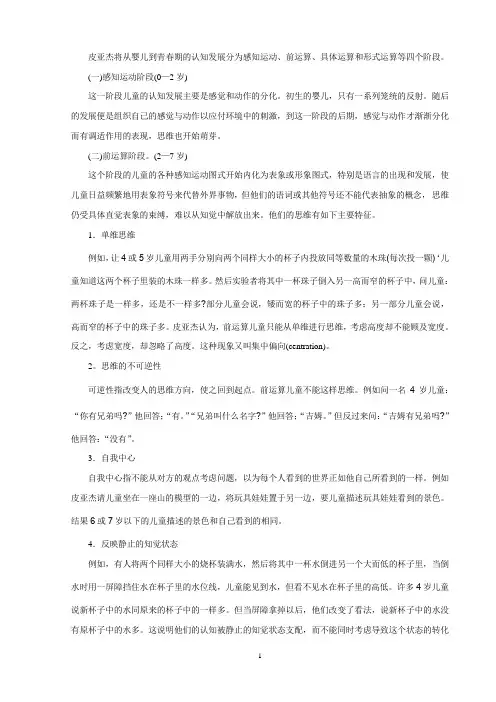
皮亚杰将从婴儿到青春期的认知发展分为感知运动、前运算、具体运算和形式运算等四个阶段。
(一)感知运动阶段(0—2岁)这一阶段儿童的认知发展主要是感觉和动作的分化。
初生的婴儿,只有一系列笼统的反射。
随后的发展便是组织自己的感觉与动作以应付环境中的刺激,到这一阶段的后期,感觉与动作才渐渐分化而有调适作用的表现,思维也开始萌芽。
(二)前运算阶段。
(2—7岁)这个阶段的儿童的各种感知运动图式开始内化为表象或形象图式,特别是语言的出现和发展,使儿童日益频繁地用表象符号来代替外界事物,但他们的语词或其他符号还不能代表抽象的概念,-思维仍受具体直觉表象的束缚,难以从知觉中解放出来。
他们的思维有如下主要特征。
1.单维思维例如,让4或5岁儿童用两手分别向两个同样大小的杯子内投放同等数量的木珠(每次投一颗)‘儿童知道这两个杯子里装的木珠一样多。
然后实验者将其中一杯珠子倒入另一高而窄的杯子中,问儿童:两杯珠子是一样多,还是不一样多?部分儿童会说,矮而宽的杯子中的珠子多;另一部分儿童会说,高而窄的杯子中的珠子多。
皮亚杰认为,前运算儿童只能从单维进行思维,考虑高度却不能顾及宽度。
反之,考虑宽度,却忽略了高度。
这种现象又叫集中偏向(centration)。
2。
思维的不可逆性可逆性指改变人的思维方向,使之回到起点。
前运算儿童不能这样思维。
例如问一名4岁儿童:“你有兄弟吗?”他回答;“有。
”“兄弟叫什么名字?”他回答;“吉姆。
”但反过来问:“吉姆有兄弟吗?”他回答:“没有”。
3.自我中心自我中心指不能从对方的观点考虑问题,以为每个人看到的世界正如他自己所看到的一样。
例如皮亚杰请儿童坐在一座山的模型的一边,将玩具娃娃置于另一边,要儿童描述玩具娃娃看到的景色。
结果6或7岁以下的儿童描述的景色和自己看到的相同。
4.反映静止的知觉状态例如,有人将两个同样大小的烧杯装满水,然后将其中一杯水倒进另一个大而低的杯子里,当倒水时用一屏障挡住水在杯子里的水位线,儿童能见到水,但看不见水在杯子里的高低。
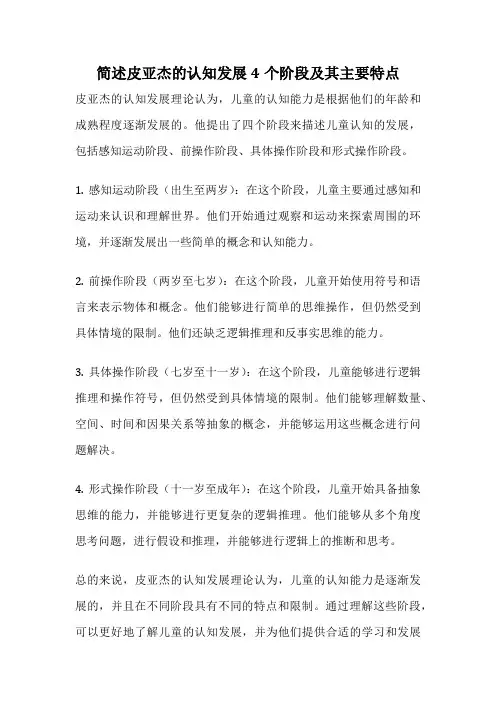
简述皮亚杰的认知发展4个阶段及其主要特点
皮亚杰的认知发展理论认为,儿童的认知能力是根据他们的年龄和成熟程度逐渐发展的。
他提出了四个阶段来描述儿童认知的发展,包括感知运动阶段、前操作阶段、具体操作阶段和形式操作阶段。
1. 感知运动阶段(出生至两岁):在这个阶段,儿童主要通过感知和运动来认识和理解世界。
他们开始通过观察和运动来探索周围的环境,并逐渐发展出一些简单的概念和认知能力。
2. 前操作阶段(两岁至七岁):在这个阶段,儿童开始使用符号和语言来表示物体和概念。
他们能够进行简单的思维操作,但仍然受到具体情境的限制。
他们还缺乏逻辑推理和反事实思维的能力。
3. 具体操作阶段(七岁至十一岁):在这个阶段,儿童能够进行逻辑推理和操作符号,但仍然受到具体情境的限制。
他们能够理解数量、空间、时间和因果关系等抽象的概念,并能够运用这些概念进行问题解决。
4. 形式操作阶段(十一岁至成年):在这个阶段,儿童开始具备抽象思维的能力,并能够进行更复杂的逻辑推理。
他们能够从多个角度思考问题,进行假设和推理,并能够进行逻辑上的推断和思考。
总的来说,皮亚杰的认知发展理论认为,儿童的认知能力是逐渐发展的,并且在不同阶段具有不同的特点和限制。
通过理解这些阶段,可以更好地了解儿童的认知发展,并为他们提供合适的学习和发展
环境。
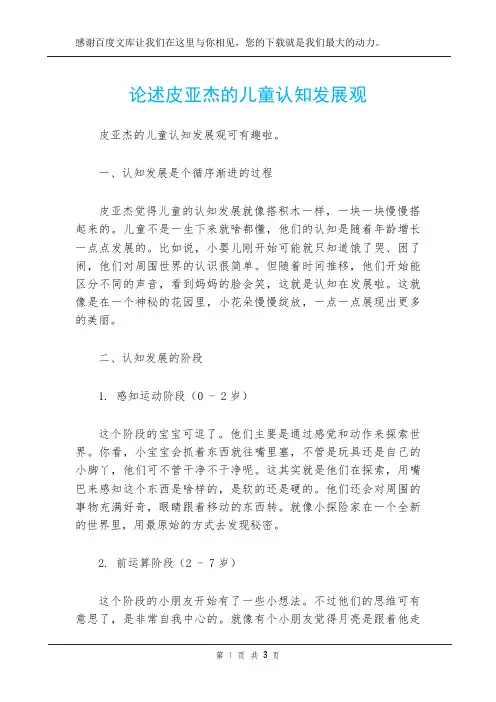
论述皮亚杰的儿童认知发展观皮亚杰的儿童认知发展观可有趣啦。
一、认知发展是个循序渐进的过程皮亚杰觉得儿童的认知发展就像搭积木一样,一块一块慢慢搭起来的。
儿童不是一生下来就啥都懂,他们的认知是随着年龄增长一点点发展的。
比如说,小婴儿刚开始可能就只知道饿了哭、困了闹,他们对周围世界的认识很简单。
但随着时间推移,他们开始能区分不同的声音,看到妈妈的脸会笑,这就是认知在发展啦。
这就像是在一个神秘的花园里,小花朵慢慢绽放,一点一点展现出更多的美丽。
二、认知发展的阶段1. 感知运动阶段(0 - 2岁)这个阶段的宝宝可逗了。
他们主要是通过感觉和动作来探索世界。
你看,小宝宝会抓着东西就往嘴里塞,不管是玩具还是自己的小脚丫,他们可不管干净不干净呢。
这其实就是他们在探索,用嘴巴来感知这个东西是啥样的,是软的还是硬的。
他们还会对周围的事物充满好奇,眼睛跟着移动的东西转。
就像小探险家在一个全新的世界里,用最原始的方式去发现秘密。
2. 前运算阶段(2 - 7岁)这个阶段的小朋友开始有了一些小想法。
不过他们的思维可有意思了,是非常自我中心的。
就像有个小朋友觉得月亮是跟着他走的,他走到哪月亮就跟到哪。
他们还不能很好地理解守恒概念呢。
比如说,同样一杯水,倒进一个高瘦的杯子和一个矮胖的杯子里,他们就会觉得高瘦杯子里的水多。
这时候跟他们解释可不容易,得想些有趣的办法,像变魔术一样给他们展示,才能让他们慢慢明白。
3. 具体运算阶段(7 - 11岁)这个时候的孩子就开始变得聪明多啦。
他们能理解一些比较具体的逻辑关系了。
像在做数学题的时候,能算出简单的加减法,还能明白一些物体之间的空间关系。
他们不再像之前那么自我中心,开始能从别人的角度去思考问题了。
就像小种子开始发芽,慢慢长出了更茁壮的枝干。
4. 形式运算阶段(11岁 - 成人)到了这个阶段,孩子们的思维就更高级了。
他们可以进行抽象的思考,可以想象一些现实中不存在的东西。
比如说,他们能理解科幻小说里那些奇特的概念,像穿越时空之类的。
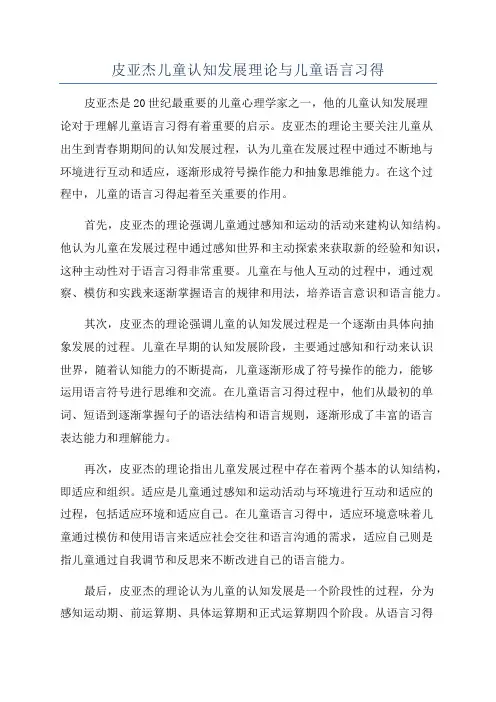
皮亚杰儿童认知发展理论与儿童语言习得皮亚杰是20世纪最重要的儿童心理学家之一,他的儿童认知发展理论对于理解儿童语言习得有着重要的启示。
皮亚杰的理论主要关注儿童从出生到青春期期间的认知发展过程,认为儿童在发展过程中通过不断地与环境进行互动和适应,逐渐形成符号操作能力和抽象思维能力。
在这个过程中,儿童的语言习得起着至关重要的作用。
首先,皮亚杰的理论强调儿童通过感知和运动的活动来建构认知结构。
他认为儿童在发展过程中通过感知世界和主动探索来获取新的经验和知识,这种主动性对于语言习得非常重要。
儿童在与他人互动的过程中,通过观察、模仿和实践来逐渐掌握语言的规律和用法,培养语言意识和语言能力。
其次,皮亚杰的理论强调儿童的认知发展过程是一个逐渐由具体向抽象发展的过程。
儿童在早期的认知发展阶段,主要通过感知和行动来认识世界,随着认知能力的不断提高,儿童逐渐形成了符号操作的能力,能够运用语言符号进行思维和交流。
在儿童语言习得过程中,他们从最初的单词、短语到逐渐掌握句子的语法结构和语言规则,逐渐形成了丰富的语言表达能力和理解能力。
再次,皮亚杰的理论指出儿童发展过程中存在着两个基本的认知结构,即适应和组织。
适应是儿童通过感知和运动活动与环境进行互动和适应的过程,包括适应环境和适应自己。
在儿童语言习得中,适应环境意味着儿童通过模仿和使用语言来适应社会交往和语言沟通的需求,适应自己则是指儿童通过自我调节和反思来不断改进自己的语言能力。
最后,皮亚杰的理论认为儿童的认知发展是一个阶段性的过程,分为感知运动期、前运算期、具体运算期和正式运算期四个阶段。
从语言习得的角度来看,这些阶段对于理解儿童语言习得的发展规律和特点有着重要的指导意义。
例如,在感知运动期,儿童主要通过感知和运动来获取语言经验,起初只能简单地模仿和使用单词;而到了具体运算期,儿童已经能够进行逻辑思维和概念形成,能够使用复杂的语言结构进行表达和理解。
综上所述,皮亚杰的儿童认知发展理论对于理解儿童语言习得具有重要的意义。

对皮亚杰认知发展理论的认识与评价皮亚杰的主要贡献之一就是对儿童智力发展规律的创造性研究。
他在人们熟视无睹的儿童幼稚行为中,发现了儿童思维的特点和规律,提出了关于儿童智力发展阶段的理论。
认知发展理论在皮亚杰的学说中占有重要位置,实际上已经成为一种完整的心理学体系的核心。
这一理论对当代发展心理学有很大影响。
标签:认知发展理论,发展心理学让皮亚杰(Jean Piaget,1896~1980)是当代杰出的儿童心理学家,日内瓦学派(Geneva School),又称“皮亚杰学派(Piagetian school)”的创始人,是建构主义认知理论的先驱。
皮亚杰早期研究儿童语言和思维等认识的发展,并从此入手,后创立发生认识论,给后人留下许多珍贵的文献。
在70多年的时间里,皮亚杰发表了88部著作,上百篇论文,撰写了无数的研究报告。
认知发展理论在皮亚杰的学说中占有重要位置,实际上已经成为一种完整的心理学体系的核心。
这一理论对当代发展心理学有很大影响,许多国内外的学者还根据这一理论进行了一系列教改实验,皮亚杰的认知发展理论有着旺盛生命力,具有非常重要的理论研究价值和实践意义。
并且,在认知发展的心理学研究中,皮亚杰所做的工作极具创造性和代表性,以至后来的发展研究虽然可以超越皮亚杰,但始终不能绕过皮亚杰。
可以说,皮亚杰是认知发展的心理学研究的先驱。
皮亚杰理论体系中的一个核心概念是“图式”。
图式是指个体对世界的知觉、理解和思考的方式,可以被看作是心理活动的框架或组织结构,是認知结构的起点和核心,或者说是人类认识事物的基础。
因此,图式的形成和变化是认知发展的实质。
皮亚杰吸收康德的先验范畴理论,改造成为遗传的“图式”,康德的先验范畴论是预成论观点。
而皮亚杰认为先天图式在认识发展的过程中仅处在一个起点的位置,图式主要是在儿童后天的活动中逐渐形成的。
结构主义强调内在结构的研究,反对外部现象的描述。
皮亚杰力图通过儿童后天的活动探讨认知结构的发生和发展。
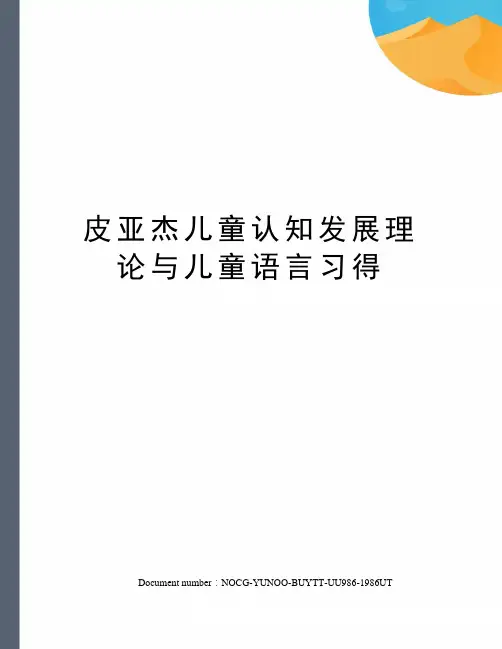
皮亚杰儿童认知发展理论与儿童语言习得Document number:NOCG-YUNOO-BUYTT-UU986-1986UT皮亚杰是当代着名的心理学家与哲学家, 他对儿童认知发展的研究是对儿童认知展理论发展研究的起源, 他的自我中心主义、道德判断、梦、模仿和游戏等理论认知不仅在西方心理学史上以及哲学史上被视为重要的里程碑, 而且对当今的教育教学也产生了深远的影响。
在过去的30 年中, 许多心理学家和教育家都皮亚杰的理论作过阐述和运用, 在此, 笔者仅对皮亚杰的儿童智力理论给中国幼儿外语教学带来的启示作进一步探讨。
一、皮亚杰的儿童认知发展理论皮亚杰的理论研究揭示了儿童认识发展的阶段性特点。
皮亚杰把个体从出生至青少年时期划分为四个相互衔接出现而又各具特点的认知发展阶段。
这些阶段主要是通过以守恒为基本特征的心理运算来划分的。
四阶段相互联系, 前一阶段是后一阶段的基础, 不可逾越, 只有完成某一阶段的发展方可步人下一阶段, 每一阶段在整认知发展中均不可或缺。
a.感知运动阶段(出生一2 岁左右)婴儿通过与周围环境的感觉运动接触, 即通过他加以客体的行动和这些行动所产生的结果来认识世界。
b.前运算阶段(2 一7 岁)儿童频繁地借助表象符号(语言符号与象征符号)来代替外界事物, 重视外部活动, 儿童开始从具体动作中摆脱出来, 凭借象征格式在头脑里进行“ 表象性思维” 。
c.具体运算阶段(7 一1岁)儿童出现了内化了的、可逆的、有守恒前提的、有逻辑结构的动作。
d.形式运算阶段(12 一巧岁) 利用语言文字, 在头脑中想象和思维, 重建事物和过程来解决问题。
对于发展的阶段性, 皮亚杰概括出三个特点: (1) 阶段出现的先后顺序固定不变, 不能跨越, 也不能颠倒。
它们经历不变的、恒常的顺序, 并且所有的儿童都遵循这样的发展顺序, 因而阶段具有普通性。
任何一个特定阶段的出现不取决八于年龄而取决于智力发展水燕皮亚杰在具体描述阶段时附上了大概的年龄期限只是为了表示各阶段可能出现的年龄范围。

认知发展与语言发展一、引言认知发展和语言发展是儿童成长过程中的重要组成部份。
认知发展指的是儿童在思维、感知、注意力、记忆、解决问题等方面的逐步成熟和提高。
语言发展则是指儿童在语言理解和表达能力方面的发展与进步。
本文将详细探讨认知发展和语言发展的相关理论、研究成果和实践经验。
二、认知发展1. 认知发展理论1.1 皮亚杰认知发展理论皮亚杰认为,儿童的认知发展经历了感知运动期、前运算期、具体运算期和形式运算期四个阶段。
在每一个阶段,儿童的思维方式和能力都有所不同。
1.2 维果茨基认知发展理论维果茨基认为,儿童的认知发展是通过社会交往和合作学习来实现的,他提出了“近发展区”和“远发展区”的概念,强调了儿童在合适的教育环境下可以达到比自身发展水平高的认知水平。
2. 认知发展的重要领域2.1 感知与运动发展儿童在感知与运动发展方面经历了从简单的感官运动协调到复杂的空间感知和精细运动控制的过程。
2.2 注意力与记忆发展儿童的注意力和记忆能力在成长过程中逐渐增强和改善,从最初的短暂注意力到逐渐延长的持续注意力,从简单的感性记忆到概念性记忆的发展。
2.3 问题解决与创造性思维发展儿童的问题解决能力和创造性思维在认知发展中起着重要作用,通过不断的实践和经验积累,儿童可以提高解决问题和创新思维的能力。
3. 认知发展的影响因素3.1 遗传因素儿童的认知发展与遗传因素密切相关,遗传基因对儿童的智力和认知能力有一定影响。
3.2 社会环境因素儿童在社会环境中的互动和学习经验对认知发展起到重要作用,家庭、学校和社会的支持和教育资源对儿童的认知发展有积极影响。
3.3 文化因素不同文化背景下的儿童在认知发展方面可能存在差异,文化对儿童的思维方式和认知风格有一定影响。
三、语言发展1. 语言发展理论1.1 乔姆斯基语言发展理论乔姆斯基认为,语言发展是儿童内在的生物学机制的结果,他提出了语言习得的关键概念“语言习得装置(LAD)”,并强调了语言的语法结构和规则在语言发展中的重要性。
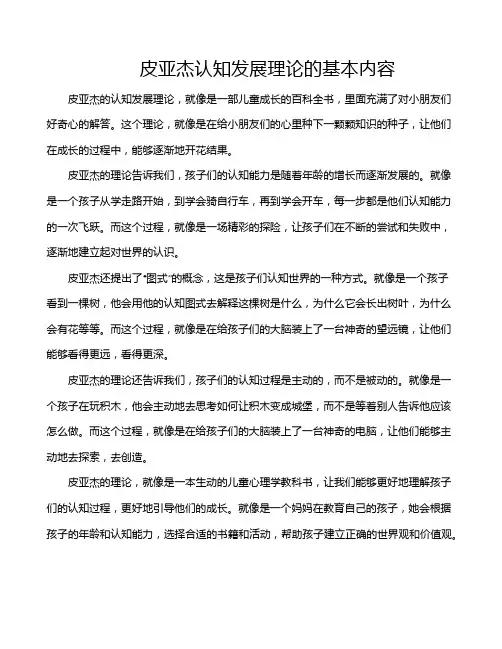
皮亚杰认知发展理论的基本内容皮亚杰的认知发展理论,就像是一部儿童成长的百科全书,里面充满了对小朋友们好奇心的解答。
这个理论,就像是在给小朋友们的心里种下一颗颗知识的种子,让他们在成长的过程中,能够逐渐地开花结果。
皮亚杰的理论告诉我们,孩子们的认知能力是随着年龄的增长而逐渐发展的。
就像是一个孩子从学走路开始,到学会骑自行车,再到学会开车,每一步都是他们认知能力的一次飞跃。
而这个过程,就像是一场精彩的探险,让孩子们在不断的尝试和失败中,逐渐地建立起对世界的认识。
皮亚杰还提出了“图式”的概念,这是孩子们认知世界的一种方式。
就像是一个孩子看到一棵树,他会用他的认知图式去解释这棵树是什么,为什么它会长出树叶,为什么会有花等等。
而这个过程,就像是在给孩子们的大脑装上了一台神奇的望远镜,让他们能够看得更远,看得更深。
皮亚杰的理论还告诉我们,孩子们的认知过程是主动的,而不是被动的。
就像是一个孩子在玩积木,他会主动地去思考如何让积木变成城堡,而不是等着别人告诉他应该怎么做。
而这个过程,就像是在给孩子们的大脑装上了一台神奇的电脑,让他们能够主动地去探索,去创造。
皮亚杰的理论,就像是一本生动的儿童心理学教科书,让我们能够更好地理解孩子们的认知过程,更好地引导他们的成长。
就像是一个妈妈在教育自己的孩子,她会根据孩子的年龄和认知能力,选择合适的书籍和活动,帮助孩子建立正确的世界观和价值观。
皮亚杰的认知发展理论,就像是一把钥匙,打开了孩子们认知世界的神秘大门。
它让我们看到了孩子们的成长过程,也让我们看到了他们的内心世界。
让我们一起来探索这个神奇的世界吧!。
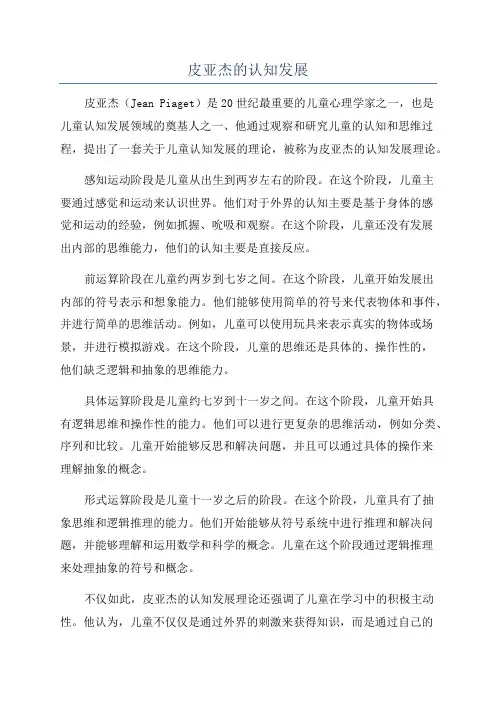
皮亚杰的认知发展皮亚杰(Jean Piaget)是20世纪最重要的儿童心理学家之一,也是儿童认知发展领域的奠基人之一、他通过观察和研究儿童的认知和思维过程,提出了一套关于儿童认知发展的理论,被称为皮亚杰的认知发展理论。
感知运动阶段是儿童从出生到两岁左右的阶段。
在这个阶段,儿童主要通过感觉和运动来认识世界。
他们对于外界的认知主要是基于身体的感觉和运动的经验,例如抓握、吮吸和观察。
在这个阶段,儿童还没有发展出内部的思维能力,他们的认知主要是直接反应。
前运算阶段在儿童约两岁到七岁之间。
在这个阶段,儿童开始发展出内部的符号表示和想象能力。
他们能够使用简单的符号来代表物体和事件,并进行简单的思维活动。
例如,儿童可以使用玩具来表示真实的物体或场景,并进行模拟游戏。
在这个阶段,儿童的思维还是具体的、操作性的,他们缺乏逻辑和抽象的思维能力。
具体运算阶段是儿童约七岁到十一岁之间。
在这个阶段,儿童开始具有逻辑思维和操作性的能力。
他们可以进行更复杂的思维活动,例如分类、序列和比较。
儿童开始能够反思和解决问题,并且可以通过具体的操作来理解抽象的概念。
形式运算阶段是儿童十一岁之后的阶段。
在这个阶段,儿童具有了抽象思维和逻辑推理的能力。
他们开始能够从符号系统中进行推理和解决问题,并能够理解和运用数学和科学的概念。
儿童在这个阶段通过逻辑推理来处理抽象的符号和概念。
不仅如此,皮亚杰的认知发展理论还强调了儿童在学习中的积极主动性。
他认为,儿童不仅仅是通过外界的刺激来获得知识,而是通过自己的主动探索和操作来建构知识。
他提出了"建构主义"的观点,即儿童通过与环境的互动来主动建构自己的认识。
总的来说,皮亚杰的认知发展理论对于理解儿童认知发展具有重要的意义。
他的理论不仅为儿童教育提供了理论支持,也为教育实践提供了指导。
通过了解儿童在不同发展阶段的认知特点,教育者可以根据儿童的实际情况来设计合适的教学策略和活动,促进儿童的认知发展和学习能力的提升。
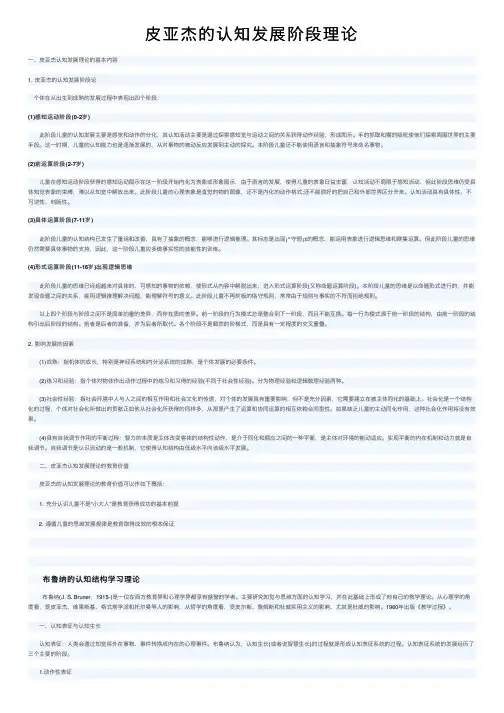
⽪亚杰的认知发展阶段理论⼀、⽪亚杰认知发展理论的基本内容1.⽪亚杰的认知发展阶段论 个体在从出⽣到成熟的发展过程中表现出四个阶段:(1)感知运动阶段(0-2岁) 此阶段⼉童的认知发展主要是感觉和动作的分化,其认知活动主要是通过探索感知觉与运动之间的关系获得动作经验,形成图⽰。
⼿的抓取和嘴的吸吮使他们探索周围世界的主要⼿段。
这⼀时期,⼉童的认知能⼒也是逐渐发展的,从对事物的被动反应发展到主动的探究。
本阶段⼉童还不能使⽤语⾔和抽象符号来命名事物。
(2)前运算阶段(2-7岁) ⼉童在感知运动阶段获得的感知运动图⽰在这⼀阶段开始内化为表象或形象图⽰,由于语⾔的发展,使得⼉童的表象⽇益丰富,认知活动不局限于感知活动,但此阶段思维仍受具体知觉表象的束缚,难以从知觉中解放出来。
此阶段⼉童的⼼理表象是直觉的物的图像,还不是内化的动作格式;还不能很好的把⾃⼰和外部世界区分开来。
认知活动具有具体性、不可逆性、刻版性。
(3)具体运算阶段(7-11岁) 此阶段⼉童的认知结构已发⽣了重组和改善,具有了抽象的概念,能够进⾏逻辑推理。
其标志是出现¡°守恒¡±的概念,能运⽤表象进⾏逻辑思维和群集运算。
但此阶段⼉童的思维仍然需要具体事物的⽀持,因此,这⼀阶段⼉童应多做事实性的技能性的训练。
(4)形式运算阶段(11-16岁)出现逻辑思维 此阶段⼉童的思维已经超越来对具体的、可感知的事物的依赖,使形式从内容中解脱出来,进⼊形式运算阶段(⼜称命题运算阶段)。
本阶段⼉童的思维是以命题形式进⾏的,并能发现命题之间的关系,能⽤逻辑推理解决问题,能理解符号的意义。
此阶段⼉童不再刻板的恪守规则,常常由于规则与事实的不符⽽拒绝规则。
以上四个阶段与阶段之间不是简单的量的差异,⽽存在质的差异。
前⼀阶段的⾏为模式总是整合到下⼀阶段,⽽且不能互换。
每⼀⾏为模式源于前⼀阶段的结构,由前⼀阶段的结构引出后阶段的结构。
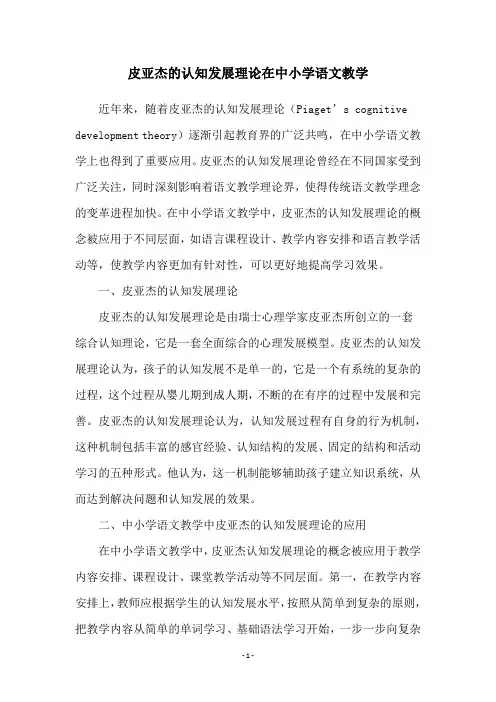
皮亚杰的认知发展理论在中小学语文教学近年来,随着皮亚杰的认知发展理论(Piaget’s cognitive development theory)逐渐引起教育界的广泛共鸣,在中小学语文教学上也得到了重要应用。
皮亚杰的认知发展理论曾经在不同国家受到广泛关注,同时深刻影响着语文教学理论界,使得传统语文教学理念的变革进程加快。
在中小学语文教学中,皮亚杰的认知发展理论的概念被应用于不同层面,如语言课程设计、教学内容安排和语言教学活动等,使教学内容更加有针对性,可以更好地提高学习效果。
一、皮亚杰的认知发展理论皮亚杰的认知发展理论是由瑞士心理学家皮亚杰所创立的一套综合认知理论,它是一套全面综合的心理发展模型。
皮亚杰的认知发展理论认为,孩子的认知发展不是单一的,它是一个有系统的复杂的过程,这个过程从婴儿期到成人期,不断的在有序的过程中发展和完善。
皮亚杰的认知发展理论认为,认知发展过程有自身的行为机制,这种机制包括丰富的感官经验、认知结构的发展、固定的结构和活动学习的五种形式。
他认为,这一机制能够辅助孩子建立知识系统,从而达到解决问题和认知发展的效果。
二、中小学语文教学中皮亚杰的认知发展理论的应用在中小学语文教学中,皮亚杰认知发展理论的概念被应用于教学内容安排、课程设计、课堂教学活动等不同层面。
第一,在教学内容安排上,教师应根据学生的认知发展水平,按照从简单到复杂的原则,把教学内容从简单的单词学习、基础语法学习开始,一步一步向复杂的文学知识深入,让学生在一个有系统的知识体系中渐进式地学习语文知识,从而更好地学习语文知识。
第二,在课程设计上,教师应该更加注重学生的认知发展的需求,把课程设计成一系列的“认知活动”,把认知发展理论的“丰富感官经历”、“认知结构发展”、“固定结构”和“活动学习五种形式”用到课堂上,实现学生的知识建构和凝聚,使学生在知识结构中不断发现新的知识,从而更好地学习语文。
第三,在课堂教学活动上,教师应尽可能用多种方式激发学生的认知活动,尽量多地给学生参与到课堂实际教学当中,用认知发展理论中的“认知结构发展”、“固定结构”和“活动学习”三种形式进行教学,让学生在知识系统中不断获得新的知识,从而掌握语言的结构和规律。
皮亚杰:认知发展的四个阶段1.感知运动阶段(0-2岁)这个阶段的儿童的认知活动,主要通过探索感知觉与运动之间的关系获得动作经验,儿童的语言和表象尚未产生。
这个时候,儿童形成了一些低级的行为图式,来适应外部环境,并进一步探索外部环境。
儿童通过看、抓和嘴的吸吮来了解外部环境。
这个阶段的后期,儿童开始使用符号和语言。
这个阶段,儿童在认知上发展了客体永恒性,知道了消逝了的事物的存在。
另外,具有了合乎逻辑的目标定向行为。
2.前运算阶段(2-7岁)运算是指内部的智力或者操作。
儿童在感知运动阶段后期,能够运用一些动作图式,但是这些图式需要与具体运动动作相联系,对于回忆过去、明了信息、做计划是无效的。
按照皮亚杰的观点,和动作分离的认知的第一种类型是使得动作图式符号化,即形成和使用字词,手势、标记、想象等符号的能力,而这些能力是前运算阶段的主要成就。
这个阶段,儿童具备了符号言语功能,词汇得到发展。
这个阶段的儿童,思维具有不可逆性,尚未获得守恒概念。
儿童还是自我中心主义的,虽然并非总会如此。
3.具体运算阶段(7-11岁)这个阶段的儿童的认知结构已经发生了重组和改善,思维具有一定的弹性,思维可以逆转。
随着守恒、分类、顺序排列、运算能力的掌握,处于具体运算阶段的学生已经发展出思维的完整性、逻辑性的体系。
在皮亚杰看来,儿童解决守恒问题的依赖于三个基本原因的理解:同一性、补偿性、可逆性。
但是这个阶段的儿童的思维仍然需要具体事务的支持,儿童还不能进行抽象逻辑思维。
对于规则的遵守,变现比较刻板。
4.形式运算阶段(11岁-成年)这个阶段的儿童的思维是以命题形式进行的,并且能够发展命题之间的关系,能够依据逻辑推理、归纳或者演绎的方式来解决问题;能够理解符号的意义、隐喻和直喻,能够做一定的概括,其思维发展水平已接近成人。
这个阶段的儿童能够进行“假设——演绎”推。
具有了系统思维能力。
这个阶段的另外一个特征就是青春期自我中心。
青少年开始非常关注自己,而且觉得他人也同样关注自己。
皮亚杰(Jean Piaget)是20世纪最著名的儿童心理学家之一,其理论对儿童认知的发展阶段影响深远。
皮亚杰提出了一套关于儿童认知发展的理论,认为儿童的认知能力随着芳龄的增长呈现出一系列的阶段性变化。
在他的研究中,皮亚杰将儿童的认知发展划分为四个阶段,分别是感知运动期、前操作期、具体操作期和形式操作期。
第一阶段:感知运动期在皮亚杰的认知发展理论中,感知运动期是最早的阶段,通常发生在诞辰后的前两年。
在这个阶段,儿童主要通过感觉和运动来认知世界,他们开始学会使用感官来认知事物,观察事物的形状、颜色、大小等,并且通过运动来感知事物的存在和位置。
婴儿在这个阶段逐渐建立起对世界的认知,通过摸索、感知和运动,逐渐形成对世界的基本认知模式。
第二阶段:前操作期前操作期一般发生在2岁到7岁之间。
在这个阶段,儿童开始逐渐具备语言能力,思维逐渐向内部化发展,但他们的认知能力仍然受到自我的限制,不能从别人的角度去思考问题,只能从自我出发。
孩子在这个阶段会出现“偏向中心”的认知倾向,即只关注事物的某忽略了整体。
第三阶段:具体操作期具体操作期一般发生在7岁到11岁之间。
在这个阶段,儿童开始具备了逻辑思维能力,能够进行简单的推理和判断。
他们开始学会进行分类、排列、组合等思维活动,能够逐渐理解抽象概念,并且能够进行简单的数学运算。
具体操作期是儿童认知发展的重要阶段,孩子在这个时期开始能够理解逻辑概念,开始具备了一定的认知抽象能力。
第四阶段:形式操作期形式操作期一般发生在11岁到成年之间。
在这个阶段,儿童的思维能力得到了进一步的发展,能够进行更为抽象的思维活动,能够进行更为复杂的逻辑推理和问题解决。
儿童在这个阶段开始具备了较强的抽象思维能力,能够进行更为复杂的数学运算和逻辑推理,开始具备了自我批判和自我反省的能力。
形式操作期是儿童认知发展的最后阶段,也是儿童进入思维成熟的标志。
皮亚杰提出的儿童认知发展的四个阶段,即感知运动期、前操作期、具体操作期和形式操作期,对我们深入了解儿童的认知发展过程和规律,对于教育教学和家庭教育都有着重要的指导意义。
皮亚杰(Jean Piaget)是二十世纪著名的瑞士心理学家,他提出了儿童认知发展的阶段论,对理解儿童认知发展的过程和特点起到了重要的作用。
皮亚杰的儿童认知发展的阶段论主要包括感知运动阶段、前运算阶段、具体运算阶段和形式运算阶段四个阶段。
本文旨在通过对皮亚杰的儿童认知发展阶段论进行简要阐述,帮助读者更好地了解儿童认知发展的阶段性特征。
一、感知运动阶段皮亚杰认为,感知运动阶段是指出生到约2岁的婴幼儿时期。
在这个阶段,婴幼儿主要通过感觉和运动活动来认识世界,表现出以感觉和动作为中心的认知特征。
婴幼儿的行为主要是由周围环境的刺激所引发的,他们对周围环境的认识主要停留在感觉印象和运动活动的水平上。
婴幼儿的思维也是非逻辑的,缺乏反思和记忆的能力,对物体的关系和数量的概念都不够清晰明了。
二、前运算阶段前运算阶段是指儿童的认知发展从2岁到7岁的阶段。
在这个阶段,儿童开始具备一定的记忆能力和语言能力,能够使用符号和象征性思维来认识和处理周围的事物。
儿童可以通过模仿、记忆和语言的使用来解决问题,但他们的思维仍然是缺乏逻辑推理和反思的,对事物的认识还停留在表面现象上,缺乏抽象和内在关系的思考。
儿童在这个阶段也容易受到成见和偏见的影响,对于新事物的认识存在局限性和片面性。
三、具体运算阶段具体运算阶段是指儿童的认知发展从7岁到11岁左右的阶段。
在这个阶段,儿童开始具备了一定的逻辑思维能力,能够根据客观事实进行思考和判断,开始具备了对抽象和内在关系的认识能力。
儿童在这个阶段具有一定的逆向思维能力,能够进行逻辑推理,理解数量的加减乘除等运算过程,能够理解分类和排序的原则。
但是这种逻辑思维能力仍然是片面和具体的,儿童的思维能力还不够成熟,对于复杂和抽象的问题还存在难以理解和处理的困难。
四、形式运算阶段形式运算阶段是指儿童的认知发展从11岁左右到成年的阶段。
在这个阶段,儿童开始具备了较为成熟的逻辑思维能力,能够通过抽象和符号性思维来进行思考和判断。
皮亚杰是一位瑞士心理学家,他提出了著名的认知发展阶段论,对儿童认知发展的理解和研究做出了重要贡献。
皮亚杰的认知发展阶段论主要包括以下四个阶段:
感知运动期(出生至2岁):在这个阶段,婴儿主要通过感官和运动来探索世界。
他们逐渐发展了运动协调能力,开始建立对象的常态和连续性概念,并逐渐形成目标导向的行为。
前运算期(2岁至7岁):在这个阶段,儿童开始使用符号和语言来表达自己的思维。
他们能够进行简单的逻辑推理,但还没有掌握具体的操作能力。
儿童在这个阶段表现出的思维特点包括自我中心性、无法逆向思考和以感性经验为基础的思维。
具体运算期(7岁至11岁):在这个阶段,儿童逐渐掌握了具体操作的能力。
他们能够进行逻辑推理,并具备一定的数量、空间和时间概念。
儿童在这个阶段开始理解逆向操作、分类、序列和保持数量不变等概念。
形式运算期(11岁及以后):在这个阶段,儿童进入了抽象思维的阶段。
他们能够进行抽象的逻辑推理,具备假设性思维和系统性思维能力。
他们能够进行复杂的问题解决和推理,思考未来的可能性。
皮亚杰的认知发展阶段论强调了儿童在不同阶段的认知能力和思维方式的变化。
他认为儿童的认知发展是逐渐由感性经验到逻辑思维、由具体操作到抽象思维的过程。
这个理论对教育、发展心理学和儿童心理学领域产生了深远影响,也为儿童教育和发展提供了指导。
皮亚杰认知发展阶段理论是瑞士儿童心理学家皮亚杰在其发生认识论、运算逻辑和儿童心理学体系中提出的关于儿童认知发展可以分为四个阶段的理论。
阶段:这四个前后相继而又有质的差异的阶段(1)感知运动阶段(出生-2岁)。
相当于婴儿期。
这是语言和表象产生前的阶段。
本阶段主要特点是:儿童只是依靠感知动作适应外部世界,构筑动作格式。
本阶段儿童在认知上的主要成就是:主体和客体分化和因果联系的形成。
(2)前运算阶段(2-7岁)。
较之前一阶段其质的飞跃表现在:由于信号功能或象征功能的出现,这一阶段的儿童开始从具体动作中摆脱出来,可以凭借象征性格式而在头脑里进行表象性思维。
这一阶段还可再分为前概念或象征思维阶段(2-4岁)与直觉思维阶段(4-7岁)这样两个小阶段。
(3)具体运算阶段(7、8-11、12岁)。
这一阶段的儿童认知和思想有两个特点,一是思维开始具有较大的变易性,出现了可逆性(“运算”概念在皮亚杰理论中本身就意味着一种可逆的动作),能解决守恒问题,能凭借具体事物或形象进行分类和理解逻辑关系;另一是能对具体事物进行群集运算,包括组合性、逆向性、结合性、同一性、重复性或多余性等运算。
但由于这一阶段的运算仍脱离不了具体事物或形象的支持,所以,其运算还是零散的、孤立的,难以组成完整的系统。
(4)形式运算阶段。
亦称命题运算阶段。
本阶段的最大特点在于:儿童思维已能摆脱具体事物的束缚,不受具体事物的内容的局限,能把形式与内容分开,进行抽象的逻辑思维,即能运用符号进行命题演算,能根据假设进行逻辑推理。
在这一阶段里,尽管儿童少年并未意识到某些形式运算结构的存在,但能运用这些结构去解决实际问题。
皮亚杰的这一理论第一次详尽阐述了儿童思维发展的基本阶段,为后人进一步对儿童思维发展过程及规律的研究作出了重要贡献。
随着时间的推移和人们对有关问题研究的深入,心理学家也提出了这一理论的某些不足之处。
Lecture Outline-----Cognitive Development and LanguageWhat is This a Case of?QUESTIONS RESPONSES What is the problem?How do you know? What evidence do youhave?Is there an alternative interpretationpossible about what is happening?Explain your answer.How would a teacher and a parentrespond to this situation? Would theyrespond differently?What information in Chapter 2 would helpyou to respond effectively?A Day in the Life of an Elementary School TeacherThoughts before students arrive:Why do I always begin the day feeling as though I’m behind? I guess it’s just part of teaching. Let’s see, what really has to be done before the kids get here? I’ve got to run off those dittoes, get my film order in for next week. . .and if I don’t make it to the teacher’s room for coffee, I may not speak to another adult all day! I love the quiet in the halls before the buses unload. I’ve got to remember to be nice to Jenny, she needs so much love. I’ve got to ask Andy about the note I sent home. I hope his parents will allow him to see the child study team.Morning duties:“No, Susie, the books aren’t here yet. I just mailed the order in last Friday. Well, you tell your mother that it usually takes about two weeks. Jack, the nurse needs to see you this morning. Oh, thanks for reminding me. Does anyone else have money for the PTA? All right, class. Please take your seats. How many people are buying lunch today?”Morning lessons:Language first. “Jack, please pass out the paper for everyone.” Creative writing-brainstorm.Some great ideas. What’s wrong with Andy again? “How about if I help you get started? Carl, what are you doing? You’re finished already? Let me see. Can you add to this? Tell me more. Come on, just try. Heather, this is really good. Mary, watch those run-ons. Is there anyone else who wants to share? Kelly, are you still writing? Yes, I’ll let you finish while we do science.”If I can just keep them busy while I get the experiment set up. . . “Page 65. Jane, would you please read. John, come here. Mr. Kuchta has the equipment I need. Please ask him if we can use it now.” “Class, these are the groups you’ll be in for the experiment. No, you may not choose your own groups. Each group should. . . It’s time to get cleaned up. Jerry Jones, stop that right now.”“Please take out your social studies homework.”I wonder what Aaron’s excuse will be today? “Well, Aaron, I’m sorry to hear that, but as I’ve said before, if you don’t have your work done you must stay in at recess time. I’ll see you then.”Another short lunch break! “Who can remember where we left off yesterday? Good, Joe. Today we’re going to. . . Jennifer, please sit down; we’re in the middle of a discussion. No, you may not get a drink right now.”Lunch:Lunch at last. Pizza day! Today’s not my day for duty, thank goodness!Afternoon lessons:After lunch, we need to switch to homogeneous groups for reading and math. Today, math is at the end of the day. I hope I didn’t plan for word problems. They do so much better on them in the morning. I’d better check my plan book.I just don’t remember what I planned. Five or six different preparations every day is just too much. “Okay class, let’s switch for math. Hi, Chrissy, go on in. Where’s Tommy? He’s still absent?” How will he ever get caught up? I love working with this group. It’s funny how a certain mixture of kids can sometimes really click!Prep period:Clean up. Pack up. Walk the class to the art room. When my prep is at the end of the day, I’m too exhausted to be productive. Don’t the flowers smell nice…and look! Who left a note?Dear Mrs. Miller,I’m sorry, I didn’t have my homework again. I promise I’m going to try harder. If I do my homework can I still stay in with you at recess?Love,AaronOh gosh, look at the clock. I’ve got to get the kids to the bus. Thirty minutes isn’t even enough time to get a full set of papers graded. “Thanks for the note, Aaron. I’m glad to hear that you’re going to try hard. Kelly, please take this note home to your mom. No, it’s not bad, it’s about our class trip. Jerry, where are you going? Oh, that’s right, you gave me a note this morning. Goodnight Susie, goodbye Joe, yes, I’ll be there Jenny. . .”After school:I hope the teachers’ meeting doesn’t last long. I promised Jenny I’d watch the field hockey game. Why don’t her parents ever come? I better take the reading papers home tonight, and I’ll have to run into town to get the salt and flour for the salt dough maps tomorrow. I still haven’t called Mrs. Shay about Bryan’s work. . .I’d like to get my hands on some of those people who call this a nine-to-five job!Adapted from the experiences of Marion Miller, 5th grade teacher in New Jersey:A Day in the Life of a Secondary School TeacherRandom thoughts on the Way to Work: “My life happens in segments just like my eight-period day. . . lots of homework last night. . . hate grading essay papers, but really enjoyed working out today’s lessons. I think they’re going to work. . . Hope I can keep Ralph quiet during fourth period. . . .”Homeroom:“At least the flag salute quiets them down. Do I have all the attendance cards in order? Almost forgot to collect insurance forms. I figured those two would forget theirs again. ‘Lost,’ they say. I’ll have to send a student to the office for extra forms.”Period 1: U.S. History (Standard): “I really feel sharp today, but I think my students are half-asleep. Is it just that the lesson’s not going as well as it could or that they’re tired? Maybe the material isn’t as good as I thought.”Period 2: Preparation Period:“I have a million things to do! I’d better beef up that U.S. history lesson before sixth period. I don’t want to put another class to sleep. My turn to use the phone in the lounge, my only link with the outside world. Coffee! A few minutes to talk with friends and check the mail.”Period 3: Economics:“I love this course, partly because it’s elective. All the kids want to be here. We can really tackle some difficult subjects. Great lesson today! The students are really getting excited. Madeline told me before class that she wants to major in economics in college. This kind of class makes it all worthwhile.”Period 4: U.S. History (Basics):“Basics. They’re rowdy but I love them. They’ve got character even thoughthey don’t give a damn about history. We have great lessons . . . . ‘Get away from the window!’. . . ‘Wait until thebell rings!”Period 5: Lunch Duty: “How demeaning to have to sit and watch kids eat!”Period 6: U.S. History (Standard): “Much better lesson than in first period. Maybe you really can learn from your mistakes. Or maybe these kids are just more awake.”Period 7: Library duty:“It’s remarkable how many students don’t know the first thing about using a library. In the beginning, I thought I would get some reading done during this period, but the interruptions make it impossible, a frustrating 40 minutes.”Period 8: Economics: “This lesson went so well this morning. What’s different? I guess last period is a terrible time to have to talk about supply and demand. We all want to go home.”End of the Day: “I’m glad I got to speak to Jane after school. Intramurals are a great way to get to know the kids. It’s easier to work with them in class now that I am learning more about them after school . . . but I’m exhausted . . . just don’t want to face three new lessons tonight. Sometimes I wish I could leave my work at the office.”Adapted from the experiences of Howard Schober, high school social studies teacher in New Jersey.Handout Master 2.5Water LevelsJesse was shown the jar labelled, "A," which contained water. The water line is marked with the letter, “f.” The jar was then tipped so that it leaned to one side. From the jars marked "B," "C," and "D," choose the one that shows where the water line will be when the jar is tipped. Which Piagetian stage would Jesse be in if she chose "B?" If she chose "C?" If she chose "D?"A B CDf ffHandout Master 2.6Cognitive DisequilibriumSelect an incident in which you (or someone you know) experienced a “disequilibrating event.” Describe that event.How did you respond to this event? Characterize your response in terms of Piaget’s ideas about accommodation and assimilation.Describe alternative ways in which you could have responded. Characterize these alternatives in terms of Piaget’s theory.How would working with peers assist a student to experience disequilibrium and re-equilibration?Four Tasks That Assess Children’s ThinkingInterpretation of stories: Read one of Aesop’s fables. Ask the children, “What do you think this story means?”Preoperational response: Response is often on an emotional, personal, level, and is based on the children’s affective reaction to the story. They are apt to mention something that happened in their own life. They may not be interested in explaining or justifying the answer.Concrete operational response: Response is based on the literal content of the story.Formal operational response: Response goes beyond the literal content of the story and indicates same understanding of the moral.Classification: Give the children the following group or objects and ask them to make a group of things that go together. Objects: picture from a magazine or newspaper, pencil, magic marker, piece of chalk, notebook paper, drawing paper, thumb tack, straight pin, masking or scotch tape, paper sack.Early preoperational: Grouping is based on a functional relationship. Example: pencil and paper, because you write on the paper with a pencil; thumb tack and picture, because you use the tack to put the picture on the wall.Late operational: Grouping is based on perceptual feature. Example: pencil, pin, and tack, because they all have a sharp point; paper and picture, because they are the same shape (have four corners); paper and chalk, because they are both white.Concrete operational: Grouping based on a common element that makes each object an example of the classification basis. Example: things made of paper, things you can write with, things you can put things on a bulletin board.Conservation: Line up two sets of wooden beads side by side. Ask the children if you both have the same amount. If they answer “yes,” then spread out one set and ask who has more beads. Return them to their original position and bunch up one set. Then ask who has more.Get two equal balls of clay. Ask the children if you both have the same amount. Make adjustments until they answer “yes.” Make a “snake” or a “pancake” out of one ball and ask who has the most clay now. Preoperational: Response will indicate that one person has more than the other when changes are made. Concrete operations: Responds that you both still have the same amount and explains his answer by using identity, reversibility, or compensation as a rationale.Combinatorial logic: Give the children five different one-digit numbers on separate small pieces of paper. Ask them to make as many different three-digit numbers as they can.Concrete operational: Goes about the task in a random, haphazard manner.Formal operational: Will approach the task in an orderly and systematic way.Piaget ReviewAs you proceed through the tutorial on CONCEPT EXAMPLE ConservationAdaptationAssimilationEquilibriumAccommodationFormal OperationalThinkingPreoperationalThinkingSensorimotorBehaviorConcreteOperationalThinkingObservation ChecklistClassroom as a WholeUse Y for “yes” and N for “no.”_____ Are children working independently?_____ Are they working in groups or clusters?_____ Does the teacher scan the classroom?_____ Are there manipulatives available to the children?_____ Do the children appear to be happy?Would you conclude that the classroom is developmentally appropriate?Your comments:Select One Child for ObservationDescribe the child’s behavior. (What is he/she doing?) What evidence do you see of the child’s status with respect to Piaget’s stages of cognitive development?Handout Master 2.10Teacher Roles in the ClassroomList the roles you expect to play in your classroom (you might refer back to Chapter 1 to help you identify roles). How would Piaget and Vygotsky have wanted you to play those roles?TEACHER ROLE PIAGET VYGOTSKY。